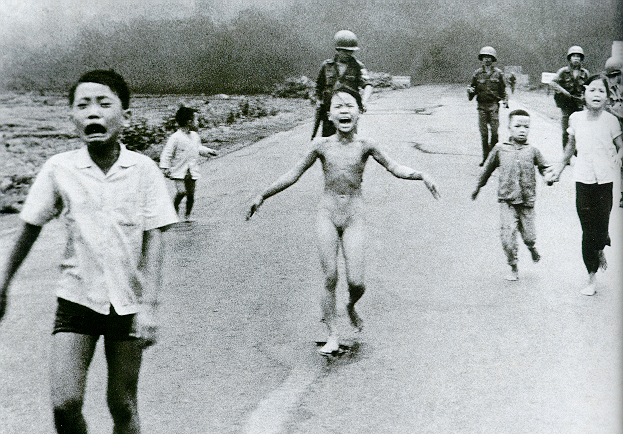|
Identification:
Vietnam Napalm, Nick Ut, 06-08-1972, Associated Press
Subject Matter: War photography, historical
Description: Photograph, 50 x 60
This image is a very familiar one. It should be – we should all
be familiar with her terror ridden eyes, the skeletal figure of a girl
running naked through the street, her clothes burned off by the Napalm
– we should be familiar with this complete divestment of humanity.
Taken by Nick Ut during the Vietnam War, “Fleeing the Napalm Attack”
was initially taken as a photo for the Associated Press.
Perhaps one of the most famous images of the Vietnam war, this image
of a young girl screaming in terror as she flees from the only home
she has ever known is one of the most visually scarring images of war.
Often times photographs are accused of not being able to properly document
the nature of tragedy, but what this photo has done is galvanize a string
of once abstract concept into something terrifyingly real. The
children in this photograph are innocent bystanders in a country torn
and ravaged by the brutal effects of war.
The background is smoky and chaotic, and the lines of the road stretch
back into some black oblivion of smog and napalm. Clearly the road ends
in death, and is both obscured and ambiguous. The figures of the soldiers
cut into the shapeless background like ominous, tangible figures of
the consequences of war, and the play of light on their bodies is a
stark contrast to the lit up bodies of the children in the foreground.
The main focus of this photograph is undoubtedly the anonymous young
girl in the center of the picture. Your eye is immediately drawn to
her, and she is the only one unclothed. Furthermore her hands are outstretched,
which is somewhat reminiscent of religious iconography, although the
connection would be stronger if her palms were upturned. Essentially
her nakedness attests to being stripped of all civil rights, human rights,
and moralities. It, however, reveals a more frightning bit of humanity,
as this is an act of dehumanization and the terrible violence inflicted
upon the innocent that are unable to help themselves. There is something
about her form that makes her seem almost in human - the protrusion
of her rib cage through pallid flesh, the somewhat boneless nature of
her right arm; the expression on her face and of those around her.
Some parallels can be drawn between this photo and the work of Munch,
and more specifically, his artwork "The Scream." This isn't
a technical term, but they are both silent pictures - they are cold
yet rife with such horror that they don't speak to you the normal way
images usually do. You want to feel distanced from the art, from the
lessons it might have buried in the canvas about the crimes against
of humanity. However whereas "The Scream" was a solitary piece
that seemed, for a the most part stage set, this photograph feels like
a fragment of a greater story, and that sense of realism that pervades
it is what elicits further sympathy by the viewer. You are aware that
the story is spilling out over the edges.
|

